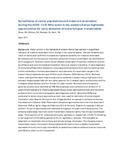Surveillance of vector populations and malaria transmission during the 2009/10 El Niño event in the western Kenya highlands: opportunities for early detection of malaria hyper-transmission

View/
Date
2011Author
Ototo, EN
Githeko, AK
Wanjala, CL
Scott, TW
Type
ArticleLanguage
enMetadata
Show full item recordAbstract
Background: Vector control in the highlands of western Kenya has resulted in a significant reduction of malaria
transmission and a change in the vectorial system. Climate variability as a result of events such as El Niño increases
the highlands suitability for malaria transmission. Surveillance and monitoring is an important component of early
transmission risk identification and management. However, below certain disease transmission thresholds,
traditional tools for surveillance such as entomological inoculation rates may become insensitive. A rapid diagnostic
kit comprising Plasmodium falciparum circumsporozoite surface protein and merozoite surface protein antibodies in
humans was tested for early detection of transmission surges in the western Kenya highlands during an El Niño
event (October 2009-February 2010).
Methods: Indoor resting female adult malaria vectors were collected in western Kenya highlands in four selected
villages categorized into two valley systems, the U-shaped (Iguhu and Emutete) and the V-shaped valleys (Marani
and Fort Ternan) for eight months. Members of the Anopheles gambiae complex were identified by PCR. Blood
samples were collected from children 6-15 years old and exposure to malaria was tested using a circum-sporozoite
protein and merozoite surface protein immunchromatographic rapid diagnostic test kit. Sporozoite ELISA was
conducted to detect circum-sporozoite protein, later used for estimation of entomological inoculation rates.
Results: Among the four villages studied, an upsurge in antibody levels was first observed in October 2009.
Plasmodium falciparum sporozoites were then first observed in December 2009 at Iguhu village and February 2010
at Emutete. Despite the upsurge in Marani and Fort Ternan no sporozoites were detected throughout the eight
month study period. The antibody-based assay had much earlier transmission detection ability than the sporozoitebased
assay. The proportion of An. arabiensis among An. gambiae s.l. ranged from 2.9-66.7% indicating a
rearrangement of the sibling species of the An. gambiae s.l complex. This is possibly an adaptation to insecticide
interventions and climate change.
Conclusion: The changing malaria transmission rates in the western Kenya highlands will lead to more unstable
transmission, decreased immunity and a high vulnerability to epidemics unless surveillance tools are improved and
effective vector control is sustained
URI
http://www.parasitesandvectors.com/content/4/1/144http://erepository.uonbi.ac.ke:8080/xmlui/handle/123456789/38805
Citation
Ototo et al. Parasites & Vectors 2011,4:144Publisher
College of Health Sciences, University of Nairobi
Collections
- Faculty of Health Sciences (FHS) [10415]
